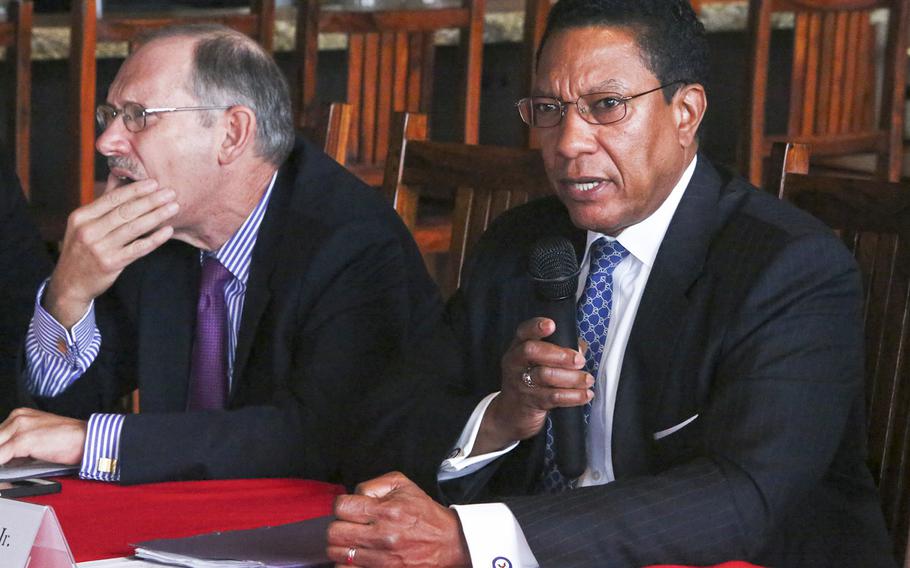
Alphonso Maldon, Jr., chairman of the Department of Defense Military Compensation and Retirement Modernization Commission, asks for service members' ideas for improvement aboard Camp Pendleton, Calif., Mar. 25, 2014. (U.S. Marines)
Military folks upset that recent defense budgets have targeted their pay and benefits have no reason to fear a new 358-page “interim” report from the Military Compensation and Retirement Modernization Commission.
The nine-member blue ribbon panel does present, in impressive detail, the full range of military and veteran pays, allowances and benefits that Congress has enacted over recent decades including the last 13 years of war. It’s a document recruiters could use to great effect if not for its heft.
But the commission reaches no conclusions on whether any of the compensation offerings, or their combined effect, is excessive. Therefore, it gives little comfort to budget analysts and even military leaders who want to dampen compensation costs through caps on pay raises and housing allowances, hikes in health care fees and cuts to the commissary benefit.
Commission Chairman Alphonso Maldon Jr., says the intent of the interim report is to present a “comprehensive resource tool” for understanding military compensation. It shows what commissioners have learned the past year, and “sets the stage” for critical analysis and recommendations to modernize compensation. A final report to President Obama and Congress is due next February.
The breadth of compensation programs for military members, retirees, reserve components, veterans and families is impressive, delivered across several federal departments. Total funding in fiscal 2014: $340 billion.
Commissioners don’t suggest here that cuts or even major policy changes are warranted due to cost growth alone. Their goal is to replace outdated programs, and “piecemeal” steps taken over time to solve compensation needs, with a more modern, flexible and efficient system.
“Although the Commission found that compensation funding has increased substantially over the last two decades, as has been repeatedly reported in the national press, these simple trends need to be examined in greater detail before any conclusion can be drawn regarding fiscal sustainability,” the report says.
It echoes a point made often by military associations and veterans groups in answer to critics who say compensation growth has been excessive the last decade or more. Any cost growth comparisons, the report says, “are highly dependent on when the comparisons are begun.”
For example, Congress did give the military annual pay raises from 1998 through 2010 that exceeded private sector wage growth, as measured by the government’s Employment Cost Index or ECI.
“Beginning the comparison in 1976, however, shows the post-1998 pay raises to be a reaction to military pay raises that were lower than ECI from 1982 through 1998,” the reports says. “Indeed, policymakers made a concerted effort around the turn of the 21st Century to increase compensation…to counteract recruiting and retention challenges...”
A second factor that boosted compensation the last 15 years was general inflation in the economy. Overall prices rose 43 percent but U.S. health costs jumped 76 percent and education costs 129 percent.
Wars, too, boosted compensation spending, the commission says, with additional manpower recruited and health care expanded to treat war-related injuries including post-traumatic stress and traumatic brain injury.
Finally, Congress did approve new military benefits. The commission highlights five since 2001 that all had big price tags:
Enactment of TRICARE for Life for Medicare-eligible military retirees and family members;
An end to a reduction or “offset” at age 62 in Survivor Benefit Plan payments, tied to eligibility for social security;
Post-9/11 GI Bill, a $10-billion-a-year expansion of education benefits for service members, veterans and their families.
Concurrent receipt, which allowed more than 500,000 military retirees to draw both full military retired pay and VA compensation for service-connected disabilities, ending a costly dollar-for-dollar offset;
Extra increases to Basic Allowance for Housing (BAH) so rates now cover 100 percent of median rental costs versus 85 percent before 2005.
The commission notes that administration’s 2015 budget seeks to slow compensation growth by capping pay and BAH increases and raising Tricare fees. The Congressional Budget Office just this week suggested that defense budget to meet Budget Control Act limits could include raising Tricare fees on retirees and ending concurrent receipt for disabled retirees.
The commission, however, isn’t ready to say such dramatic changes are needed to make personnel account sustainable. Indeed, the report makes another point often argued by military personnel advocates: that despite significant growth personnel costs, funding for compensation still represents roughly 30 percent of the Department of Defense budget.
The commission acknowledges that defense budgets face tough budget challenges. It also concedes that having compensation costs equal to a third of total defense budgets is not “evidence of fiscal sustainability.”
Indeed, it says, whether personnel costs are sustainable might be better assessed by comparing growth of pay, health care, retirement and quality-of-life programs the last 15 years against growth of private sector wages using the ECI or of the economy using Gross Domestic Product (GDP).
The report presents this comparison in a line graph without comment. However, the lines depicting military and VA health costs since 1998 are seen soaring above those for ECI and GDP. Elsewhere, the report notes that Tricare Prime premiums rose by only 17 percent from 1999 to 2013, while premiums for private sector workers increased 196 percent.
What commissioners actually want to change about military pay and benefits won’t be known for seven months.
We do know, and the interim report emphasizes, that the final report will not call for cuts to retirement benefits for current members or to those already retired. The commission charter doesn’t allow it.
Send comments to Military Update, P.O. Box 231111, Centreville, VA, 20120, email milupdate@aol.com or Twitter: @Military_Update